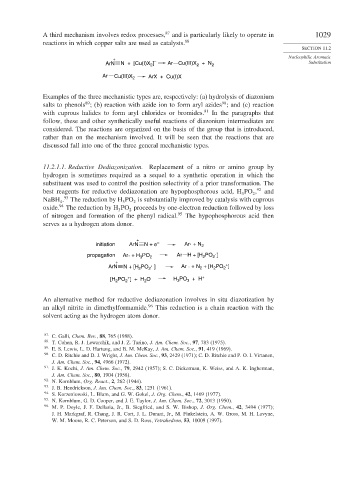Page 1053 - Advanced Organic Chemistry Part B - Reactions & Synthesis
P. 1053
A third mechanism involves redox processes, 87 and is particularly likely to operate in 1029
reactions in which copper salts are used as catalysts. 88
SECTION 11.2
Nucleophilic Aromatic
+
ArN N + [Cu(I)X 2 ] – Ar Cu(III)X 2 + N 2 Substitution
Ar Cu(III)X 2 ArX + Cu(I)X
Examples of the three mechanistic types are, respectively: (a) hydrolysis of diazonium
89
90
salts to phenols ; (b) reaction with azide ion to form aryl azides ; and (c) reaction
with cuprous halides to form aryl chlorides or bromides. 91 In the paragraphs that
follow, these and other synthetically useful reactions of diazonium intermediates are
considered. The reactions are organized on the basis of the group that is introduced,
rather than on the mechanism involved. It will be seen that the reactions that are
discussed fall into one of the three general mechanistic types.
11.2.1.1. Reductive Dediazonization. Replacement of a nitro or amino group by
hydrogen is sometimes required as a sequel to a synthetic operation in which the
substituent was used to control the position selectivity of a prior transformation. The
best reagents for reductive dediazonation are hypophosphorous acid, H PO , 92 and
2
3
93
NaBH . The reduction by H PO is substantially improved by catalysis with cuprous
4 3 2
94
oxide. The reduction by H PO proceeds by one-electron reduction followed by loss
2
3
of nitrogen and formation of the phenyl radical. 95 The hypophosphorous acid then
serves as a hydrogen atom donor.
+
.
initiation ArN N + e – Ar + N 2
.
propagation Ar. + H PO 2 Ar H + [H PO ]
2
2
3
+ .
+
ArN N + [H 2 PO ] Ar . + N + [H PO ]
2
2
2
2
+
[H PO ] + H O H PO + H +
3
3
2
2
2
An alternative method for reductive dediazonation involves in situ diazotization by
an alkyl nitrite in dimethylformamide. 96 This reduction is a chain reaction with the
solvent acting as the hydrogen atom donor.
87 C. Galli, Chem. Rev., 88, 765 (1988).
88
T. Cohen, R. J. Lewarchik, and J. Z. Tarino, J. Am. Chem. Soc., 97, 783 (1975).
89 E. S. Lewis, L. D. Hartung, and B. M. McKay, J. Am. Chem. Soc., 91, 419 (1969).
90 C. D. Ritchie and D. J. Wright, J. Am. Chem. Soc., 93, 2429 (1971); C. D. Ritchie and P. O. I. Virtanen,
J. Am. Chem. Soc., 94, 4966 (1972).
91
J. K. Kochi, J. Am. Chem. Soc., 79, 2942 (1957); S. C. Dickerman, K. Weiss, and A. K. Ingberman,
J. Am. Chem. Soc., 80, 1904 (1958).
92 N. Kornblum, Org. React., 2, 262 (1944).
93
J. B. Hendrickson, J. Am. Chem. Soc., 83, 1251 (1961).
94 S. Korzeniowski, L. Blum, and G. W. Gokel, J. Org. Chem., 42, 1469 (1977).
95 N. Kornblum, G. D. Cooper, and J. E. Taylor, J. Am. Chem. Soc., 72, 3013 (1950).
96
M. P. Doyle, J. F. Dellaria, Jr., B. Siegfried, and S. W. Bishop, J. Org. Chem., 42, 3494 (1977);
J. H. Markgraf, R. Chang, J. R. Cort, J. L. Durant, Jr., M. Finkelstein, A. W. Gross, M. H. Lavyne,
W. M. Moore, R. C. Peterson, and S. D. Ross, Tetrahedron, 53, 10009 (1997).

